Every morning sound of bird’s song will be more joyful and refreshing to hear while waking up. Bird is a warm-blooded egg-laying vertebrate animal distinguished by the possession of feathers, wings, a beak, and typically by being able to fly. The bills of birds make them one of the most beautiful species on Earth. The long curved beaks of some birds help them to finding food easily, also make more attractive than other birds. Most Birds can fly, using powerful muscles to flap their wings. There are about ten thousand living species, more than half of which are passerine, or “perching” birds. Birds have wings whose development varies according to species. Birds are social, communicating with visual signals, calls, and songs, and participating in such behaviors as cooperative breeding and hunting, flocking, and mobbing of predators. Songbirds, parrots, and other species are popular as pets. Recreational bird watching is an important part of the ecotourism industry. Many species of birds are economically important as food for human consumption and raw material in manufacturing, with domesticated and undomesticated birds being important sources of eggs, meat, and feathers. Here is the list of top 10 birds with Aamazing beaks.
1.Rhinoceros Hornbill

Rhinoceros hornbills are large colorful birds found in tropical forests of Southeast Asia. Rhinoceros horn bill have upward curve casque on their bill, just like rhino horn, native to rain forest of Indonesia, Southern Thailand and Singapore. Their huge bill and casque are orange and red. The rhinoceros hornbill is a large arboreal hornbill, 80 to 90 cm (31–35 in) long. This casque is largest one among horn family, which also brings this common name for them. They are predominately black in color, with white legs and a white tail with a black band.
Male’s casque are little bigger than that of female birds. The rhinoceros hornbill is the state bird of the Malaysian state of Sarawak and the country’s National Bird. It took almost six for the completion of growth of casque over the bill of rhinoceros horn bill. They also this casque to amplify it’s calls, becomes so loud, can hear throughout the forest. The diet of the rhinoceros hornbill is dominated by fruit, but it will take any insect, small reptile, rodent, and smaller birds that it can catch. In captivity it can live for up to 35 years.
2.Great Hornbill
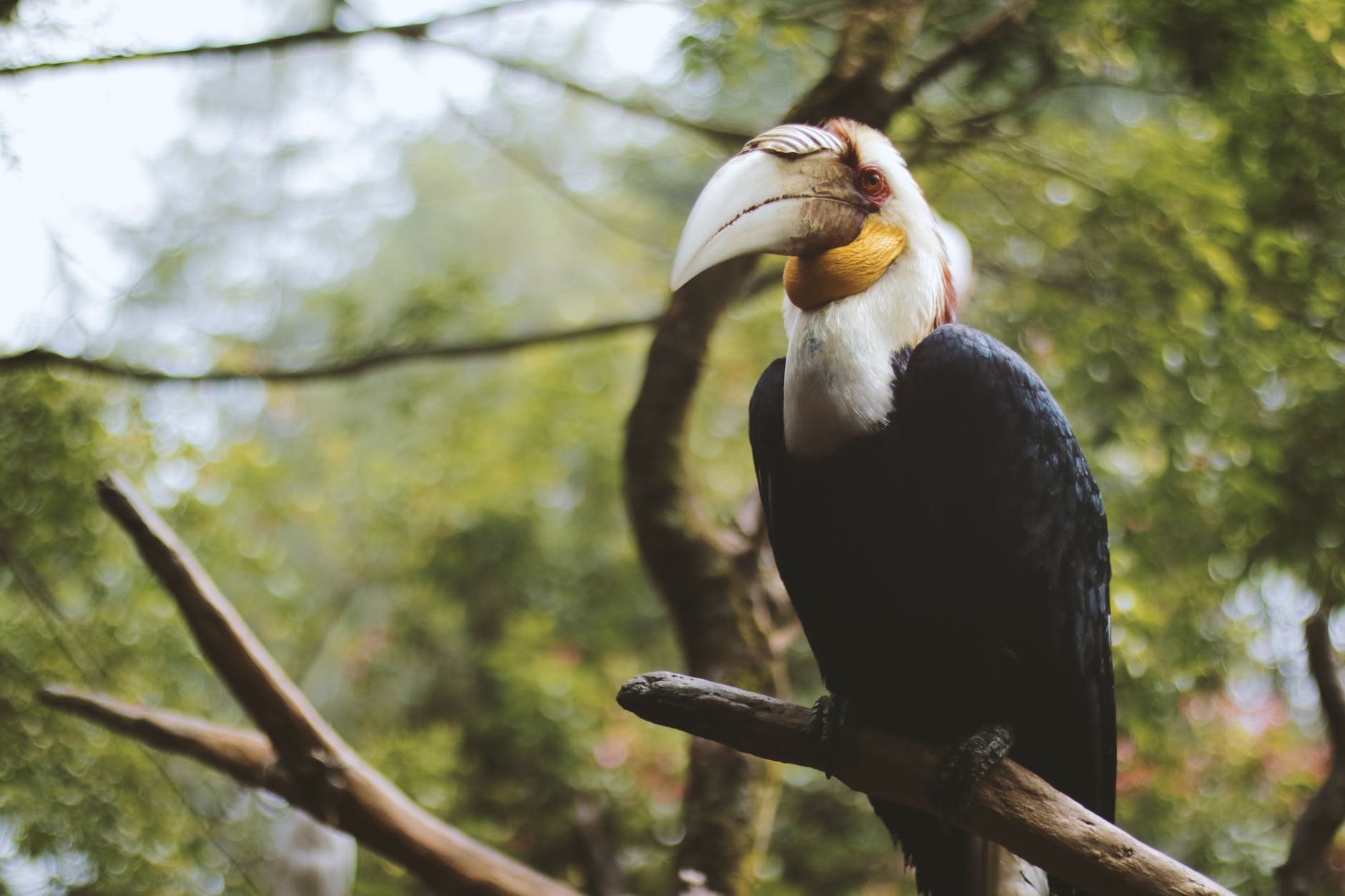
The great hornbill is a large bird with a very large bill, which bears a sizable, brightly colored, horny growth known as the casque. The body is mostly black with a white neck, wing coverts, and flight feathers. The great hornbill is a large bird, 95–130 cm (37–51 in) long, with a 152 cm (60 in) wingspan and a weight of 2 to 4 kg (4.4 to 8.8 lb). The average weight of 7 males is 3 kg. Great horn bills are one of largest members of hornbill family native to Southeast Asia. They have yellow colored curved massive bill, the black and yellow mixed casque at top of bill becomes prominent feature of great horn bill. The great hornbill has a wide distribution and can be found in China, India, Nepal, Bhutan, Bangladesh Myanmar, Thailand, Laos, Vietnam, Cambodia, Malaysia, and Indonesia.
The Great Hornbill (Buceros bicornis) also known as the concave-casqued hornbill, great Indian hornbill. The large majority of the population is found in India. It takes eggs, amphibians, reptiles, insects, mammals, and small birds as diet. The greater hornbill is able to consume as many as 150 figs during one meal. The casque on top of bill have a concave shape and no special purpose other than sexual selection. During breeding season great hornbill also make loud duet, rapid mixture of barks and roar. The great hornbill is long-lived, living for nearly 50 years in captivity.
3.Keel-Billed Toucan

The keel-billed toucan is a large bird with mostly black plumage and a very large multi-colored bill. It has red and white coverts under and on top of its tail, green skin around the eyes and lore (the area between the eyes and the bill), a yellow face and throat, and blue legs. This species has a very large range and can be found in Belize, Bolivia, Colombia, Costa Rica, Guatemala, Honduras, Mexico, Nicaragua, Panama, and Venezuela. The toucan’s beak appears quite heavy, but is actually light. It is hollow, made of the protein keratin with thin rods of bone for support. Keel billed toucan also called as rainbow billed toucan because of colored large bill, native to South America.Their bil grow up to a length of 20 cm, almost one third of length of their body.
keel-billed toucan is one of the colorful beaks in the world, can see different colors, but green color is found to be spread in most of all areas. This bird is a poor flyer, moving from tree to tree mostly by hopping. The length of bill of keel-billed toucan doesn’t affect balance of body as it is very light, but very strong. Keel-billed toucan is an omnivore. They usually feed on fruits and berries, also like to have insects, lizards and small frogs. Keel-billed toucan lives in the tree holes together with 5 to 6 other birds.
Female lays 1 to 4 eggs in the cavities of trees. Both male and female take part in the incubation of eggs that lasts 16 to 20 days. Keel-billed toucan can survive 15 to 20 years in the wild.
4.Flamingo
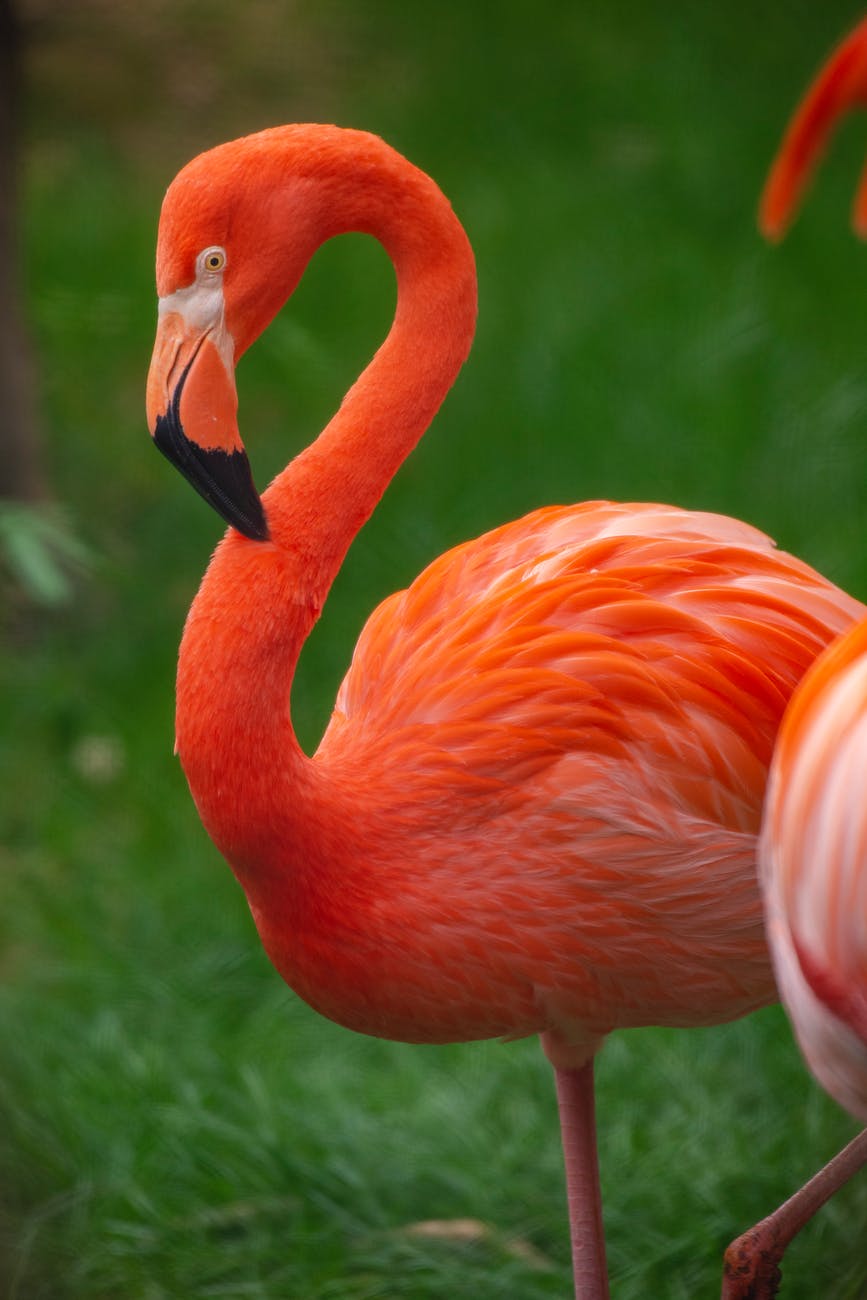
These birds live in shallow lakes, mangrove swamps and sandy islands of Africa, Asia, America and Europe. Adult bird is 3.3 – 4.6 feet tall and weigh between 3.3 – 9 pounds. There are six distinct species of Flamingo. Flamingos are large pink colored birds found in saline and alkaline lakes of many continents. Just like color of feather the unique shape of beak makes flamingos to special among species of birds. Adult flamingos’ feathers range from light pink to bright red due to their food supply. The brighter the feathers, the more well-fed the flamingo is. Baby flamingos don’t have curved bill, it becomes curved after few months. Their bent bills acts like a filter, help to feed on small fishes, plankton and larvaes from mud. The bills have black color at tip and pale orange at part next to head.
The Flamingo is the National bird of The Bahamas. Flamingos are a familiar sight even to those who have never seen one in real life. Flamingos used to feed in flocks, in that way they can alarms other flamingos whose head are down in mud, in searching for food. Flamingos feed by stirring up mud with their feet. Flamingos hold their breath while feeding. They also found in colonies in breeding time. Flamingos are monogamous and they produce one egg each year. Both mother and father keep the egg warm before it hatches. Flamingos also born in grey color and only turn to pale color after two year. Few days after hatching both parents will start feeding their chick with milk-like substance rich in fats and proteins. Flamingos live between 20 and 30 years.
5.Shoe Bill
The most prominent feature on the shoebill’s body is its beak. It is large and shaped like a shoe, which is the reason why the bird is named “shoebill”. Beak is 9 inches long and 4 inches wide. It ends with a nail-like hook, which is used for killing of the prey. Shoebill feeds during the night. Shoe bills are pre-historic looks tall bird native to Africa. This beautiful bird can be found only in eastern parts of Africa, all the way from Sudan to Zambia. Te bulbous bill of this birds grow up to a size of 9.4 inches, have grayish marking in it. Shoebill is very large bird. It can be reaching 1.5 pounds in weight. The sharp edges of mandibles help them to catch prey easily.
It can stay silent for very long period of time while waiting for the prey to appear, it is often called “statue-like” bird. Before swallowing, shoebill with cut the prey in half with its sharp bill. They also have a sharp hook at tip of the bill, can easily pierce on any prey. They also feed on Fishes, frogs, fish, amphibians, lizards, water snakes, snails. Baby crocodiles and turtles. Nests are built with grass. Female lays one to three eggs. They will hatch after 30 days-long incubation. Young shoebills will fight with one another. Shoebill can survive more than 35 years in the wild. They frequently live in areas that humans find hard to reach.
6.Roseate Spoonbill
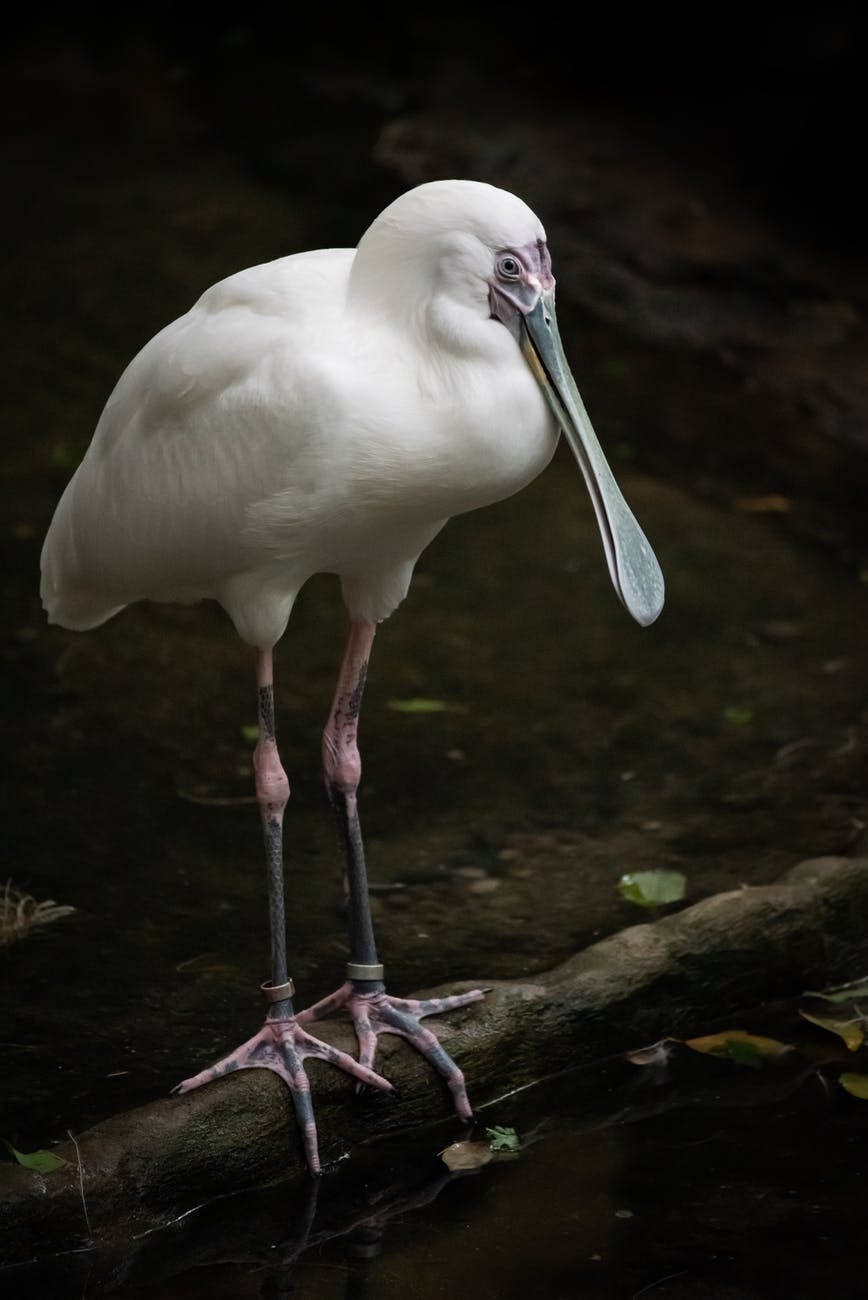
The unique spoon like beak itself brings this common name for this bird. This wading bird use their special beak to collect food like small aquatic insects and fishes. Their bills are very long and flattened, found in large numbers in Caribbean shores, Central America, Mexico, southern Florida, coastal Texas and southwestern Louisiana. Spoonbills fly in long diagonal lines with their necks and legs completely stretched out. The roseate spoonbill receives its bright coloring from the pigments of the crustaceans that it eats. Reaching a height of up to 2.5 feet (80 centimeters), the roseate spoonbill’s wingspan can stretch 1.5 times as wide, reaching up to 4 feet (120 centimeters). There are six species of spoonbill in the world; the Roseate Spoonbill is the only one with pink plumage. Spoonbills use their specialized bills to feed. They sweep their open bills through the water, and when a prey item like a fish or insect comes between the mandibles, the bill snaps shut.
The long legs of roseate spoonbills help them easily walk in water, the bright pink coloring feathers also makes this species of bird more attractive. In the United States, a popular place to observe roseate spoonbills is “Ding” Darling National Wildlife Refuge in Florida. Roseate spoonbills must compete for food with snowy egrets, great egrets, tricolored herons and American white pelicans. The roseate spoonbill nests in shrubs or trees, often mangroves, laying two to five eggs, which are whitish with brown markings. Immature birds have white, feathered heads, and the pink of the plumage is paler. The bill is yellowish or pinkish.
7.American White Pelican
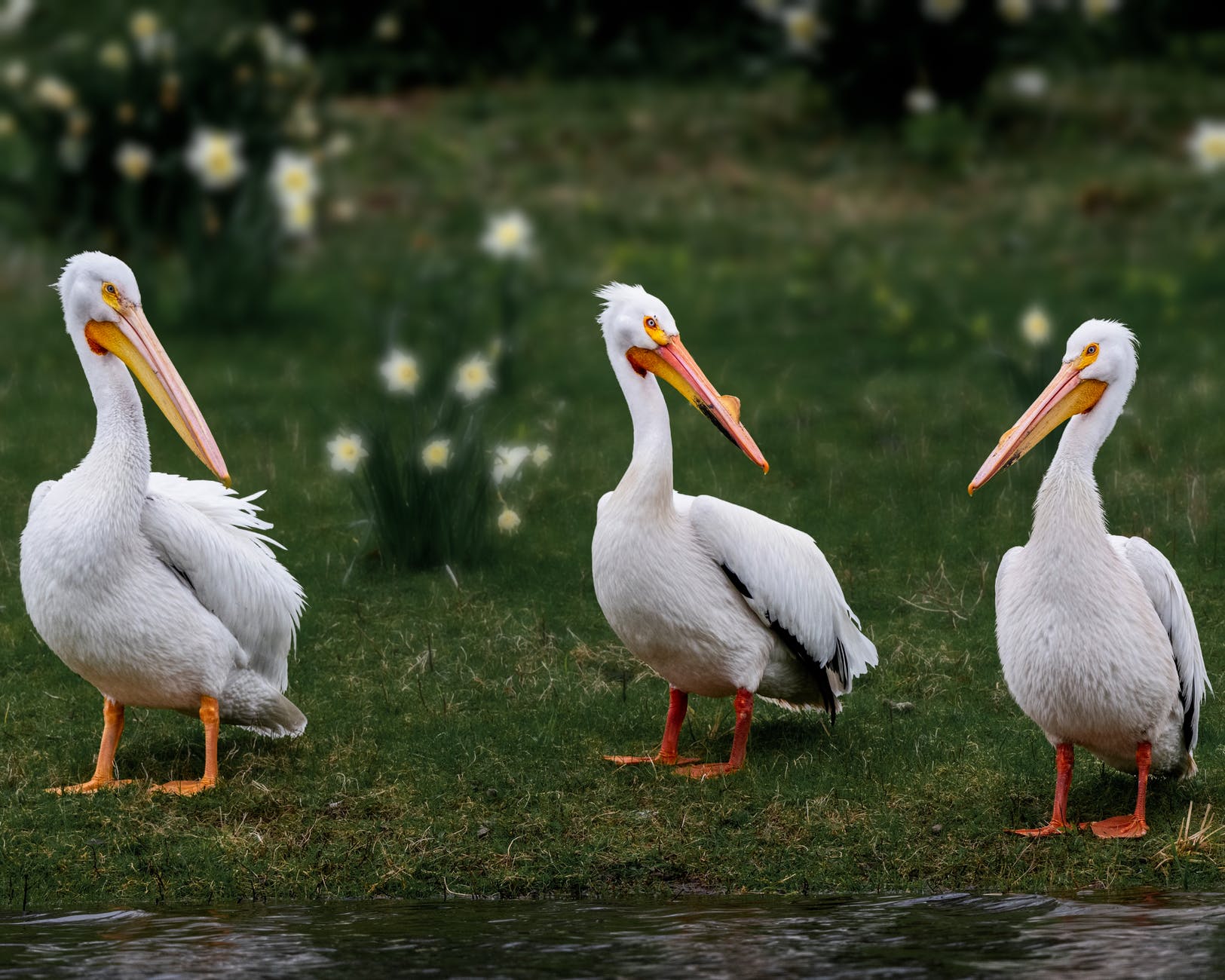
Largest aquatic bird in the world native to Central and South America. They grows up to a size of 70 inches and their huge beak measures up to 15.2 inches. The lower mandible of American white pelican acts like a filter, help them to catch fishes and to filtered out the water. In breeding season their bill becomes more deep in color, vivid orange colors. Interestingly a unique ‘horn’ will also grows in upper bill of American white pelican during breeding season. This type of horn never can seen with other pelican species. Pelican is an amazing bird that can be found in all continents except on the Antarctica. The Pelican family is at least 30 million years old. There are eight species of pelicans. The American White Pelican grows a temporary “Horn”. Its bill can reach 18 inches in length. Pelicans technically have nasal openings. However, in all eight species, the nostrils are sealed off, buried under the beak’s horny sheath. Pelicans predominantly breathe through their mouths. Underneath the bill, pelicans have throat pouch that can hold 3 gallons of water. Pouch is mainly used for feeding. They don’t store food in the Pouch on their Bills.
Some males have colorful feathers while others have ability to change the color of the pouch, neck and bill into bright colors during courtship. Pelican is easily recognized by its large body, short legs with webbed feet. Webbed feet are used for swimming and diving. They can fly to the height of 10 000 feet using the warm wind currents. It can eat 4 pounds of fish per day. Main food of Pelicans is fish, they can also eat turtles, crustaceans and tadpoles. Very hungry pelicans will even attack and eat seagulls. While diving for fish, pelicans can end up in fishing nets. Brown Pelicans are on the list of endangered species. Both males and females are in charge of the building of the nests that are usually located on the trees near the water. Nests are built using the feathers, leaves and sticks. Female lays 1 to 3 eggs. Incubation period lasts between 28 and 36 days. Young pelicans eat by scooping the food from the bills of their parents. Pelicans can survive between 10 and 30 years in the wild. Pelicans are very social birds. They live in large colonies composed of several hundreds of birds. The Dalmatian pelican (Pelecanus crispus) is the largest member of the pelican family and perhaps the largest freshwater bird in the world in length and weight by swans.
8.Black Skimmer
The unique long beak of black skimmer make them totally different from that of other shore birds. The bill is long but thin, the lower mandible is longer than upper one. The part of bil nearest to head is deep orange and nearest to tip is deep black. Black skimmers are large tern-like seabirds that can be found in the Americas. Black skimmers inhabit coastal marshes, sandy shores and islands, shallow bays, estuaries, lagoons, creeks, inlets, and rivers. This unique shaped bill also help them in searching for food, drags the lower bill while they flies over surface of water, help them to catch small fishes easily. Adults in breeding plumage have a black crown, nape and upper body. The forehead and under parts are white.
The upper wings are black with white on the rear edge, and the tail and rump are dark grey with white edges. Non-breeding adults have paler and browner upperparts, and a white nape collar. Immature birds have brown upperparts with white feather tips and fringes. The under parts and forehead are white, and the under wings as the adult. Baby Black Skimmers are born with their upper and lower mandibles the same length. Black Skimmer pairs share parental duty. Males and females both incubate the eggs – in fact, male Black Skimmers even have brood patches. Both parents also brood the newborn chicks and feed the nestlings. Although Black Skimmers spend most of their life near water, they do not swim. Black Skimmers use their elongated lower mandibles to feed by skimming it over the water. Black skimmers usually feed in large flocks, travel at distance of 5 miles in searching for food.
9.Atlantic Puffin
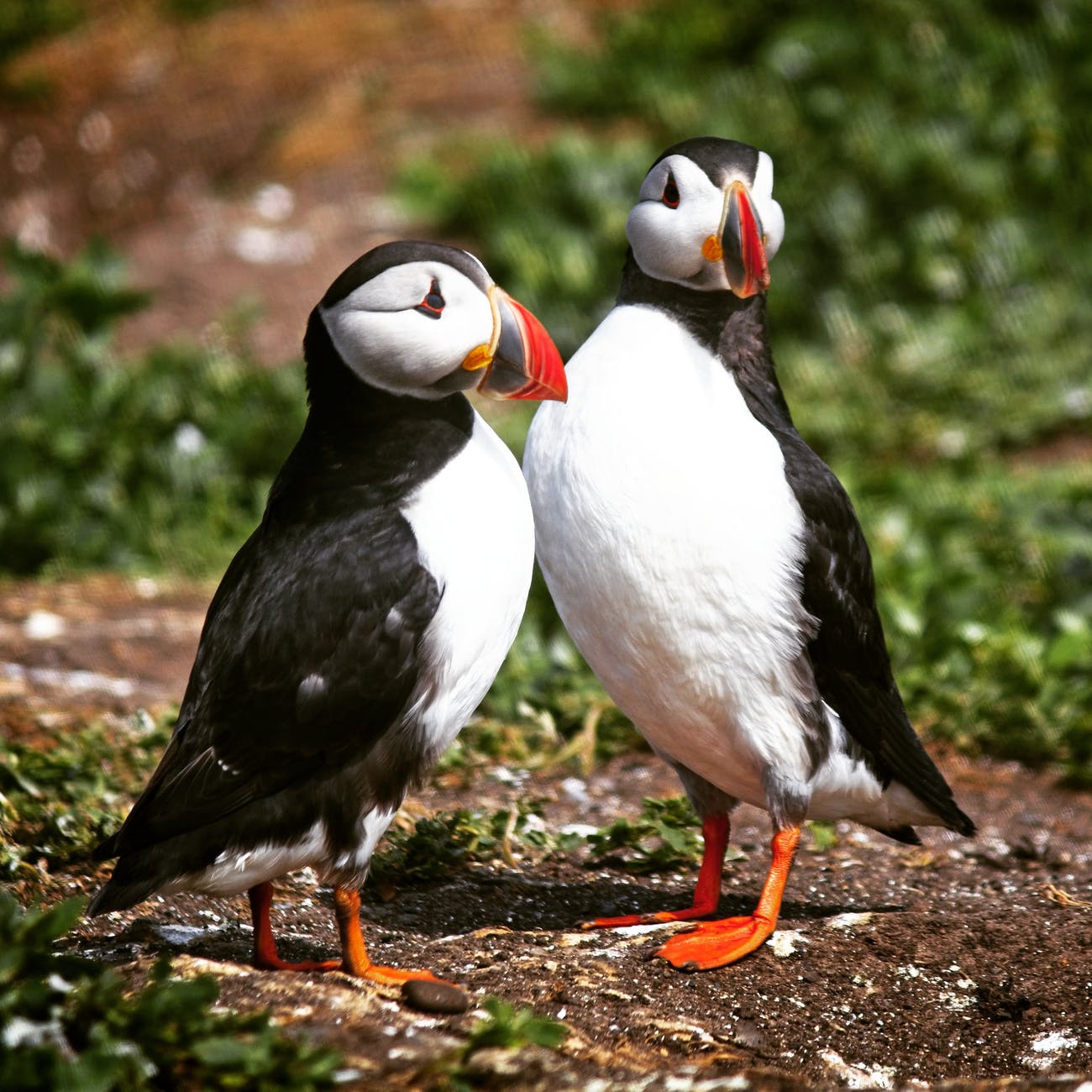
The Atlantic puffin has become Iceland‘s most precious bird and a tourist attraction. He is both captivating and peculiar and has been nicknamed ‘Sea Parrot’, ‘Penguin of the North’ and even ‘Clown of the Sea’ and is also known as the Common Puffin. In Iceland we just call him ‘Lundi’. The Atlantic puffin has black and white feathers and a large and colorful beak. It is a seabird in the auk family that breeds in and around Iceland. Atlantic puffin is an attractive species of seabird native to Atlantic ocean. They have a colorful broad and triangular beak, half nearest tip of beak is orange inc color and half nearest to head is slate grey. Only adult Atlantic puffins have such broad bills, younger on growing stage the upper edge curve of bill develops. Atlantic puffins have penguin like colors, called as clown of sea.
They spend most of their lives at sea, used to rest in waves. Using their wings also swims underwater, dive at depth of 200 meters, can catch number of fishes at a time using broad beak. The waterproof feathers allows them to stay wars when they float in ocean. Puffins spend most of their lives out at sea, resting on the waves when not swimming. Puffins are carnivores and live off small fish such as herring, hake and sand eels. Puffins mate for life. Puffins don’t make nests, they dig holes. The female puffin only lays one egg each spring. In the wild, these winged wonders live for around 20 years. The puffin is a poor flier. The puffin is an excellent swimmer.
- Long Billed Curlew
Long-billed Curlews spend the summers in areas of western North America with sparse, short grasses, including short grass and mixed-grass prairies as well as agricultural fields. Male and female Long-billed Curlews look pretty much alike, but females have a longer bill with a more pronounced curve at the tip than males. The 8.6 inch long bills in 26 inch body becomes main attraction on this species of bird. The long bill curved downwards, have long neck and small head. The female bird have longer bill than that of male birds. The long bill helped them to catching shrimps and crabs from deep tidal mud flats. They also feed on earthworms and grasshoppers. Long-billed curlews are able to swim if necessary, having webbed front toes. The long bill of this bird allows it to reach shrimp and crabs in their deep burrows in the mudflats. The bill’s end is controlled by separate muscles, so it acts like a finger. Cinnamon-brown underwings visible in flight. Feeds by probing mud with bill or dunking head under water. These birds Breeds from southern Canada to northern California, Utah, northern New Mexico, and Texas.
It has been known as “sicklebird” and “candlestick bird.” Candlestick Point in San Francisco was named after this indigenous bird. Long-billed curlews are mainly carnivorous. When in grasslands, this bird eats grasshoppers, crickets and beetles. It also eats small amphibians. In its winter habitat, small crustaceans, mollusks, seeds and berries form its diet.
Long billed curlews used to make nest in dry places using material such as pebbles, grass, stems, twigs and seeds. Both parents look after the young, females usually abandon the brood to the male 1–3 weeks after hatching and depart for winter grounds. The chicks also leave the nest soon after hatching. Male and female Long-billed Curlews incubate the eggs and care for the brood. The parents both defend the nest; usually the female incubates during the day, with the male taking his turn at night. They are one of eight species of curve-billed shorebirds in the genus Numenius, many of which are experiencing rapid population declines, and two of which, Eskimo Curlew and Slender-billed Curlew are recently extinct or likely so, respectively.

